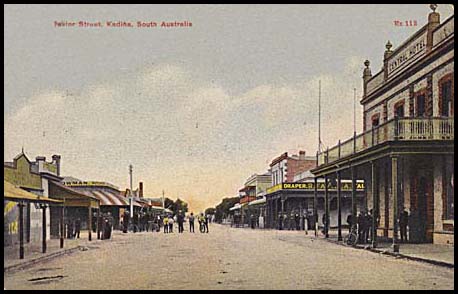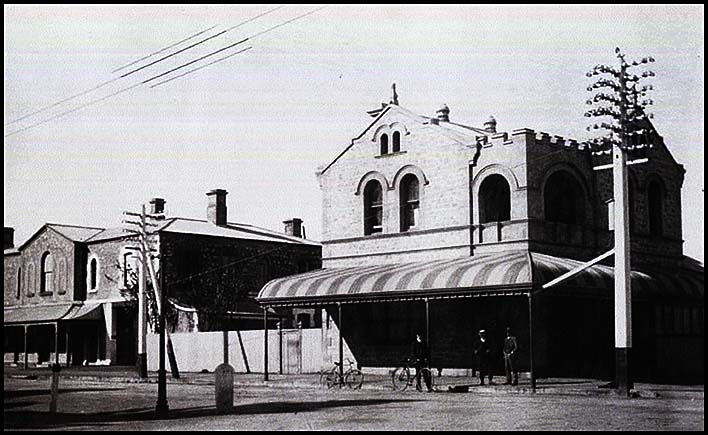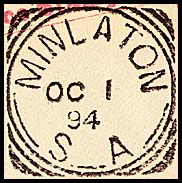Telegraph Offices down the Yorke Peninsula.
- Home, index, site details
- Australia 1901-1988
- New South Wales
- Overview of NSW
- Telegraph lines
- Telegraph Offices
- Date stamps
- Forms
- Envelopes
- Rates
- Stamps
- Queensland
- Overview of Qld
- Telegraph lines
- Telegraph offices
- Date stamps
- Forms
- Envelopes
- Rates
- Stamps
- South Australia
- Overview of SA
- Telegraph lines
- Telegraph Offices
- Date stamps
- Forms
- Envelopes
- Rates
- Stamps
- Tasmania
- Overview of Tasmania
- General developments
- Reports
- Organisation
- Telegraph lines
- Telegraph Offices
- Date stamps
- Railway lines
- Forms
- Envelopes
- Rates
- Stamps
- Overview of Tasmania
- Victoria
- Overview of Vic.
- Telegraph lines
- Telegraph offices
- Date stamps
- Forms
- Envelopes
- Rates
- Stamps
- Ephemera
- Western Australia
- Overview of WA
- Telegraph lines
- Telegraph Offices
- Date stamps
- Forms
- Envelopes
- Rates
- Stamps
The following Telegraph Offices are included in this page:
| Althorpe Island | Ardrossan | Cape Spencer | Curramulka | Edithburg | Kadina |
| Maitland Bay | Marion Bay | Moonta | Port Wakefield | Port Victoria | Stansbury |
| Troubridge | Wallaroo | Warooka | Yorketown |
|
Telegraph communication began on this island on 28 September 1911. The telegraph office was closed on 1 June 1920. |
|
The Telegraph Office opened on 10 February 1879 nearly two years after the Post Office. |
|
On 26 June 1879, the Minister of Education informed the House that it was the Government's intention to build a Post Office and a Telegraph Station at Bramfield and that, as a site had been selected, tenders for the construction would be called shortly. A Telegraph Office opened at Bramfield on 14 August 1924!! |
|
Telegraph and trunk facilities opened on 1 December 1922. The name changed to Inneston on 1 February 1928. |
|
A public meeting was convened on 30 August 1879 to discuss various issues important to the township. In relation to the telegraph, Mr. Wilson proposed
On 5 July 1884, a representative meeting of residents convened
At another public meeting on 28 March 1885, Mr. W. A. Beaglehole, the Chairman said that "He and his colleague had done their best towards getting a Post Office and Telegraphic communication for the township. They had waited on the Treasurer, who had recently forwarded a reply to the effect that the office would be erected, but that communication by telegraph would not yet be extended to Curramulka". Neverthless, a telegraph line was opened to Curramulka on 13 October 1885. A Post Office had apparently been previously announced in August 1877 and it is possible (according to Walker p. 94) that postal facilities were even operating in 1876. Perhaps they had been closed. |
| Kadina.
The telegraph connection to Adelaide was established on Friday 5 September 1862 about one year after the Post Office and the occasion was marked with the usual transmission of messages of congratulations. Several Government buildings were constructed by Messrs. Haines & Co at the same time - a new Court House, a Police Station and the Post & Telegraph Office. When completed, the present Court House could again be used as the Police stable. |
|
|
|
||
The long serving manager of the Gawler Telegraph Office - Mr. D. G. Sands - was appointed to the Kadina Office in May 1865. A letter to the Editor of the Wallaroo Times of 20 December 1882 stated in part:
In June 1905, the Mayor asked the Postmaster-General to place on the estimates the amount of £2,000 for the construction of a new Post & Telegraph Office at Kadina. Tenders for the construction were let in March 1906 for a cost of £1, 532 6/-. |
||
In addition to basic postal date stamps being used on telegrams, Kadina also used a rubber circular date stamp (RC2 - KTO):
|
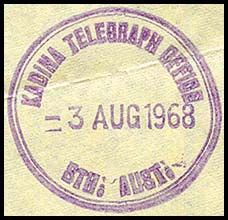 3 August 1968. Used on AA-DO-13D. |
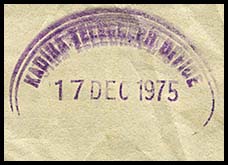 17 December 1975. Used on AA-DO-13D. |
| Maitland. The telegraph connection with Adelaide was made on 18 June 1877 about three years after the Post Office. At the same time, tenders were called for the construction of the offices. Having achieved telegraphic connection to Maitland, the South Australia Chronicle of 29 September 1877 reported a problem of building the Telegraph Office: "Mr J. J. Duncan, M.P., introduced a deputation to the Commissioner of Public Works on Tuesday morning, September 25, consisting of Messrs. James Pearce, James Smith, J.P., A. Waterman, and T. O'Brien. Their object was to delay the erection of the proposed Telegraph Office at Maitland on the present plan and to obtain, if possible, its erection, even if at a future date, on a more extended basis. It was said that the building originally contemplated was suited to the requirements of the place but now it was proposed to erect two small rooms - one 12 feet x 12 feet, and the other 12 feet x 16 feet. To erect such a building would, in view of the increasing importance and trade of the locality, be a waste of money and it was thought it would be better to wait some little time before erecting the building rather than build a small and unsuitable building. The Commissioner promised to look into the matter". A town meeting was also held in Maitland on 13 November "urging upon the Government immediate attention to the requirements of the district in the construction of a Post and Telegraph Office of sufficient size for the business of the place and accommodation for the official in charge". At least there was a reaction because on 22 December 1877 it was reported that "about £1,000 has been placed on the Estimates for telegraph and post office accommodation, the place used at present not being equal to the requirements of the township. A messenger is also very much wanted, particularly during the wheat-buying season". Mr. J. W. Hillman was Gazetted to be Post and Telegraph Master at Maitland in February 1878 while Miss Smythe was transferred to Minlaton - much to the regret of residents. Given that appointment, residents of Maitland now hoped that tenders might be called for the erection of a Post & Telegraph building at Maitland. The present accommodation is regarded as being totally inadequate given the increasing importance of Maitland. |
||
| On 7 October 1878, the Foundation Stone for the new Post Office and Telegraph Station was laid.
By November 1878, the "Post Office and Telegraph Station is beginning to make a show but I am afraid it will be some time yet before it is finished" (Adelaide Observer 9 November 1878). On 2 April 1879, the new Post and Telegraph Office at Maitland opened. |
 Maitland Post & Telegraph Office about 1910. |
|
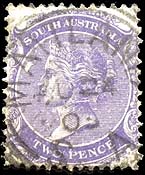 Maitland 24 August 1903. Squared circle cancellation. |
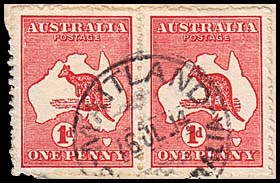 Maitland. 16 July 1914. Usual Post Office cancellation. |
|
The Telegraph Office opened in 1905. Marion Bay was a safe refuge for ships to use as a shelter in case of bad conditions. On some occasions, ships suffered serious damage at sea during wild weather and managed to get to Marion Bay before taking on water. |
On 1 March 1913, The Register included a report on a line repairing team's visit to Marion Bay:
|
| Minlaton.
The Telegraph Office opened on 15 March 1878 - one year after the Post Office. On 11 May 1883, a tender was accepted to build the new Post & Telegraph Office for the cost of £765. |
||
A squared circle date stamp was used on telegrams at Minlaton.
|
|
|
|
The telegraphic line to Adelaide was opened on 21 December 1865. The Telegraph Office was opened in September 1866. The Estimates had allocated £1,400 for the half year to December 1865 to construct the Telegraph Station. On 2nd January 1866, the South Australian Advertiser noted that Moonta was one of five locations where "telegraph extension has been sanctioned". |
||
Prior to 1865, the community were agitating that Kadina and Wallaroo had services which Moonta should also have. For example a letter by Luke L. Furner to the Editor of the SA Register on 19 May 1864 , stated the case as follows:
A public meeting was held on 17 August 1865 to select a site for the Post Office and Telegraph Station. One suggestion was that it should be as near to the mines as was possible for the sake of the whole community. Discussion then centered around whether the Government had requested the inhabitants of the township and the miners to be consulted or just the township people. If the latter was correct, then the building should be erected in the centre of Moonta. Even the Post Master (who pointed his position had plenty of work, plenty of abuse and little pay) agreed that it was the inhabitants who had to be consulted. The lack of clarity was referred back to the Government. The new Telegraph Station and Master's House were finished in September 1866 and the Superintendent was expected in mid-October to move instruments and open the new office. Due to duties elsewhere, Mr Todd could not attend at Moonta until mid December. Telegraphic communication from Moonta to Adelaide and other places was therefore possible only from Thursday 21 December 1865. Mr. Bastard, the appointed operator, was unable to be present. The South Australian Advertiser of 19 September 1879 (p. 5) related that "By kind permission of the Postmaster-General, a chess match by telegraph has been arranged between the Port Adelaide and Moonta Mines Chess Clubs to be played on Friday evening September 26". |
|
"The new Port Victoria Telegraph Office was opened by Mr. E. Squire, Assistant Superintendent of Telegraphs yesterday - 16 February 1879. The usual congratulatory messages were sent to His Excellency, the Minister of Education and the Postmaster-General. Champagne having been introduced, various loyal and patriotic toasts were honoured. Miss Abbott is in charge of the office. The thanks of the people here are due to Mr. Squire for, notwithstanding many difficulties principally the late arrival of the necessary fittings, the office was opened by the time promised". (Evening Journal, 17 February 1879). The Telegraph Office opened about two years after the Post Office. |
|
The Telegraph Office opened on 31 March 1879. A Post Office had been opened in 1876. "The foundations of our Post and Telegraph Office are dug out and the whole structure will probably be finished in two months" (Adelaide Observer 9 November 1878). In the late 1870s or so, Mr. H. E. Matthews was transferred to Stansbury from Yorktown. |
|
The telegraph office opened in 1882. It was closed on 1 March 1922. The South Australian Advertiser of 29 March 1867 reported the following sad story:
|
| Wallaroo.
The Telegraph Office opened on Monday 16 March 1863 - about two years after the Post Office. In June 1908, the plans for a new Post & Telegraph Office were released. The Advertiser described them (on 13 June 1908) in the following way:
|
||
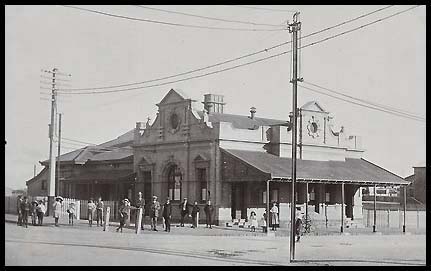 The new Wallaroo Post and Telegraph Office circa 1910. |
||
Squared circle date stamps:
Possible telegram usage on a transmission form. Cost for a message sent within SA (outside 15 miles) with one additonal word was 10d. |
|
|
| SC1 circular date stamps. Has time slug. 2 mm side arcs. STH. AUSTRALIA at base.
|
.jpg) 15 October 1915. Used on SI DO-5A. |
.jpg) 24 April 1918. Used on SI-DO-4B. |
| No time slug. 4 mm side arcs. STH AUST at base.
|
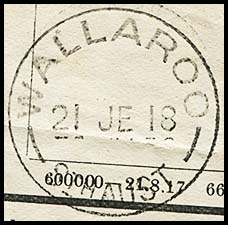 21 June 1918.. Used on SI-DO-6A. |
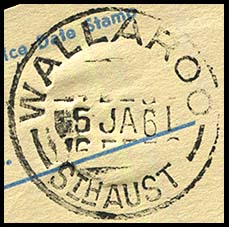 5 January 1961. Used on AW-DO-10 (58). |
| Warooka.
The Telegraph Office opened on Thursday 22 May 1879 about six years after the Post Office. At that time, Warooka was about four years old and consisted of a public-house, a black smith's shop, a branch of a Yorketown store, four or five private dwelling-houses and two small places of worship. The district was comparatively sparsely populated for, although there were some good patches of agricultural land, there were large portions that can never be utilised for that purpose on account of their rocky or swampy character. |
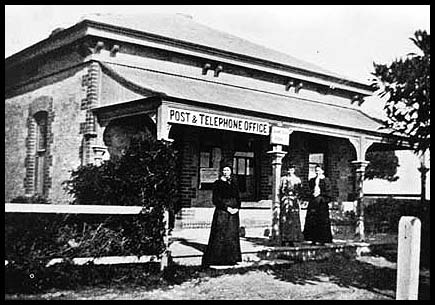 Warooka Post and Telegraph Office circa 1900. Source: NLA: D5440 2728. |
The Telegraph Office building was a three roomed cottage which had been rented from the storekeeper. It was also used as a Post Office and residence for the Postmistress, who was also the operator. The office was fitted up by Mr. Matthews, the Postmaster and operator at Yorketown. The article cited below in the Chronicle admits "It is self-evident that the new Telegraph Station does not come under the category of reproductive works and there are not wanting those who should be qualified to judge correctly who assert that the business done at the office will not pay for the kerosine consumed". The South Australian Chronicle of 31 May 1879 reported the opening and noted:
The necessity of the road was also described eloquently in the same report:
On 19 August 1882, the South Australian Advertiser reported on public sentiment that "it is to be hoped that the Government will shortly see fit to erect a new Post Office and Telegraph Office as the present structure is altogether inadequate for the requirements of the neighborhood". In 1884, £780 was allocated for the construction of a new P&T office. |
|
|
The telegraph connection opened on 2 July 1877. The plans for the Post and Telegraph Office had been placed on public display in June 1877. On 3 August 1877, tenders for the construction of the Post Office and Telegraph Station at Yorketown were gazetted - James Tyrie won the contract at £725. The town was previously called Weaners Flat because it was where the pastoralists separated the lambs from the ewes. About 1900, the Postmaster was Mr. H. E. Matthews - and there is truly remarkable story about him.
|
|

